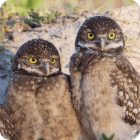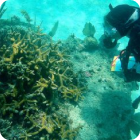
By: Kyle Grammatica
Jeff Liechty, Coastal Biologist at Audubon’s Florida Coastal Island Sanctuaries, works with many Florida sea birds. But the ones closest to his heart are the royal and sandwich terns he banded during his graduate work from 2012-2014.
“I was studying tern breeding ecology at Nicholls State University,” he explained. “Specifically hatching success, survival, site fidelity, and diet of Royal Terns and Sandwich Terns on Isles Dernieres Barrier Islands Refuge. These islands were directly impacted by the Deepwater Horizon oil spill and the project sought to understand how the birds use the islands, the surrounding waters, and how their populations were faring in the aftermath of the tragedy.”
Almost a decade later, Jeff and researchers are still collecting band resight information to help answer these questions and learn more about the species. Jeff’s banding project has discovered that many Sandwich Terns head east from Louisiana after nesting season and follow the Florida shoreline south along the Gulf Coast, sometimes along the Atlantic Ocean as well. While terns do linger in Florida throughout the winter, the majority appear to move into the Caribbean. Some have even ventured as far away as the Pacific Coast of Panama.
“These birds travel thousands of miles each year and rely on resources throughout that range to complete their annual cycle,” Jeff shared. “It’s a privilege to see them each fall as they pass through southwest Florida where I can continue to appreciate their beauty, and occasionally cross paths with one that I banded. It gives me hope to see a flightless chick that I held in my hands eight years ago still out there doing its tern thing.”
If you’ve found a banded bird, you can record your sighting here. Reports of banded birds help researchers like Jeff better understand a species, and with more knowledge, conservation efforts are more effective!
We fund research and conservation projects for Florida wildlife, from Florida panthers to frosted flatwoods salamanders. You can help us protect our wildlife by purchasing our Conserve Wildlife plate. The plate has funded over $1.5 million in conservation efforts so far, and with your help, we can increase that number! Buy yours online now!











